
- 1. What is SEMrush?
- 2. Main features of SEMrush
- 2.1. 1. Organic Research on SEMrush
- 2.2. 2. Traffic Analytics - Traffic analysis.
- 2.3. 3. Paid Search - paid search engine
- 2.4. 4. SEMrush - Keyword Gap
- 2.5. 5. SEMrush - Keyword Overview
- 2.6. 6. SEMrush - Keyword Magic Tool
- 2.7. 7. SEMrush - Keyword Difficulty Tool
- 2.8. 8. Position Tracking - track ranking
- 2.9. 9. SEMrush - Site Audits
- 2.10. 10. SEO Content Template
- 2.11. 11. Organic Traffic Insights
- 2.12. 12. SEMrush - Link Building
- 2.13. 13. On Page SEO Checker
- 2.14. 14. Social Media Toolkit
What is SEMrush?
SEMrush is a tool to analyze website indexes and the most effective web SEO today. This tool will research keywords, analyze competitors. Thereby, SEMrush helps you optimize SEO and the best Google Ads advertising strategy
Semrush is a great tool, however, it's quite costly. In case you are looking for a budget solution, consider using our Semrush Group Buy service to save some money on this excellent SEO tool.
Main features of SEMrush
1. Organic Research on SEMrush
Organic Research will give you information about user visits resulting from organic search traffic.
You do it by including your competitor's website link in SEMrush .
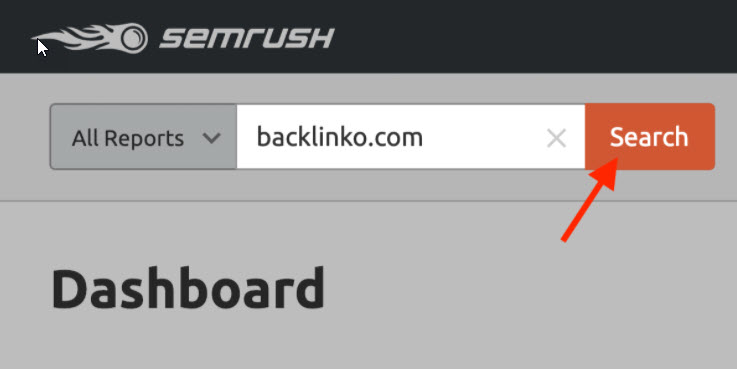
At SEMrush, you can access a lot of useful databases.
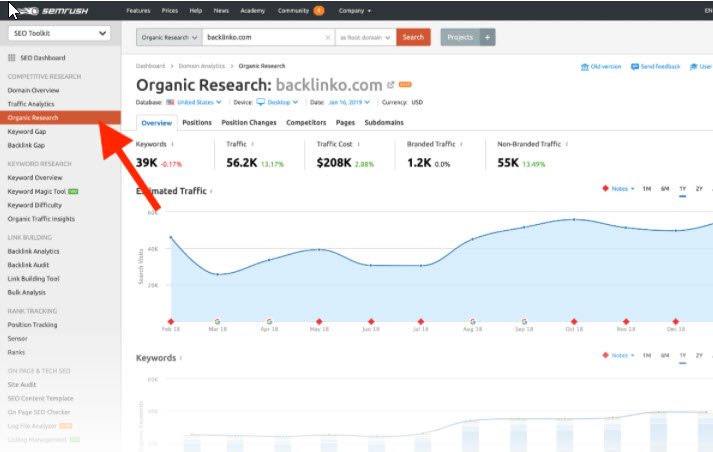
Let Organic Research analyze each website metric you recommend quickly.
First, you have "Keywords".
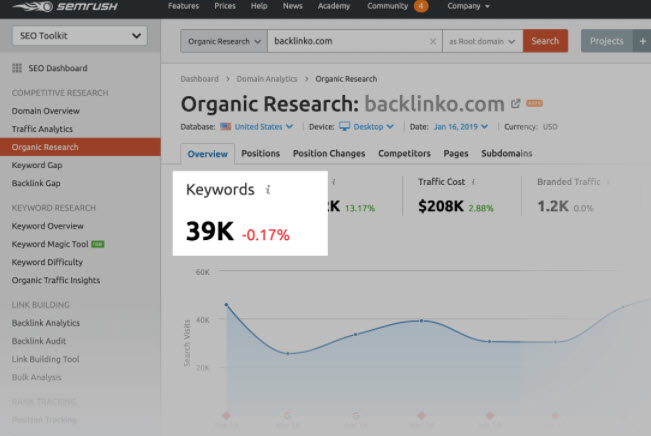
This is the total number of user keyword searches that Organic Research measured for this website.
In my opinion, this figure is not very good. Think of it, a website is ranking on page 2 and it contains 1000 keywords. However, the organic user traffic for the 1000 keywords that lead to that site is almost zero. Specifically, the site's keywords are not ranked in the top 10. So I think the metric. This is not satisfactory.
Second, you will have "Traffic" (traffic online)
These are Organic Research estimates of the total online user traffic to the website from all search engines.
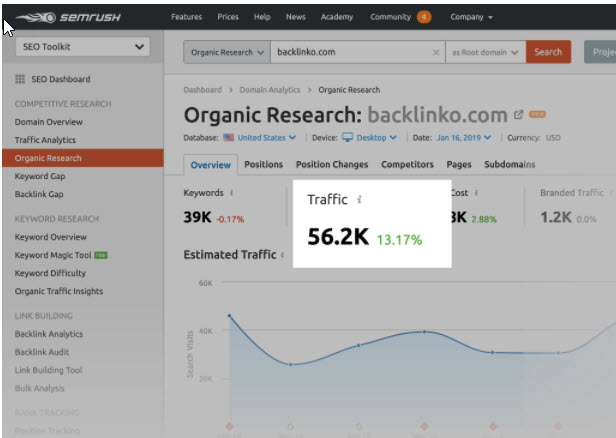
This number is 100% accurate. Thanks to this parameter, you can evaluate how your competitors are SEO with you.
In the end, this is the most remarkable metric compiled by Organic Research. - "Traffic Cost" (Cost of access)
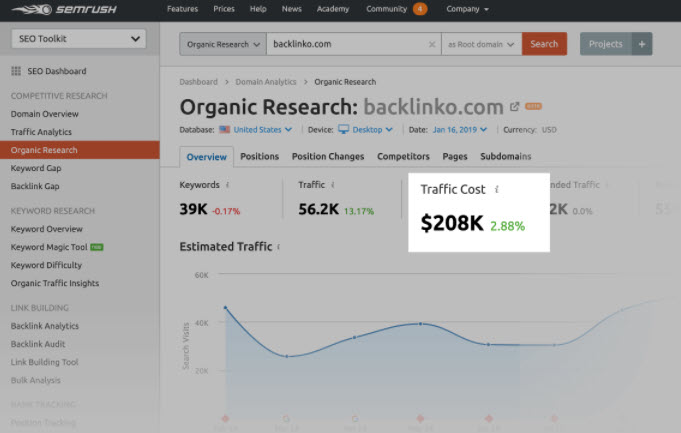
Traffic cost is the amount that Organic Research estimates the site is earning from organic traffic obtained.
(Let's say you have received money for a corresponding amount of traffic from PPC)
Because this metric determines how much money will be in the account. It is also the result of traffic on your website. So Traffic cost is my favorite metric in the entire Organic Research application.
For example, try putting Nerd Wallet's website in Organic Research to check it out. You can see how amazing amount of income they are getting. That is $ 73 million from monthly SEO traffic.

The content searched for free
This is where you can see the ranking of all the keywords that the site has.
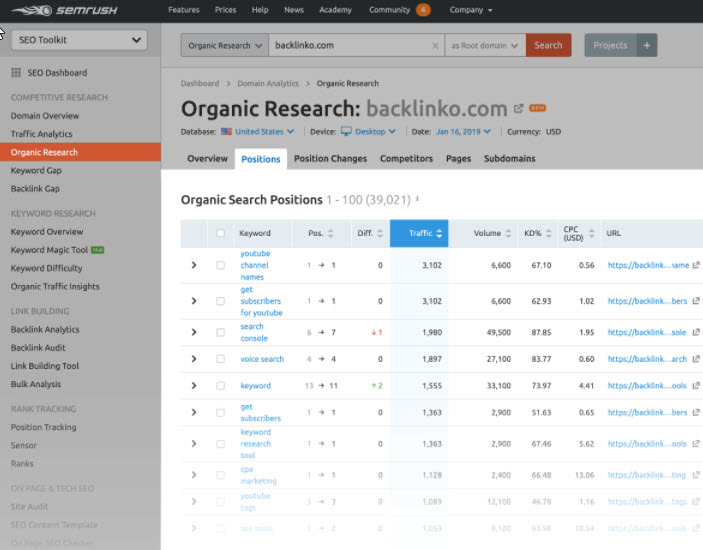
And here are the rankings
This is extremely useful for keyword research
Instead you have to set up keywords from the free Google Keyword Planner tool. Here you will get a clean list of keywords.
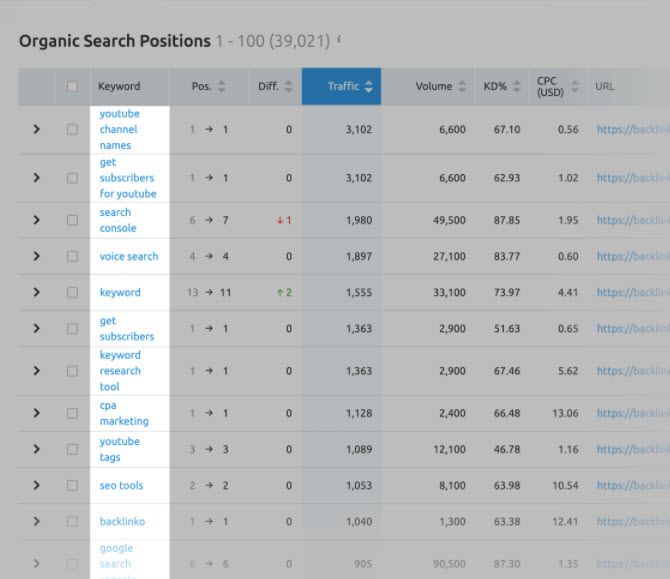
Thus, if a certain keyword in your competitor's website is always in the top search rankings, you can do the same thing.
By default, Organic Search Positions on SEMrush will show the keywords with the most traffic.
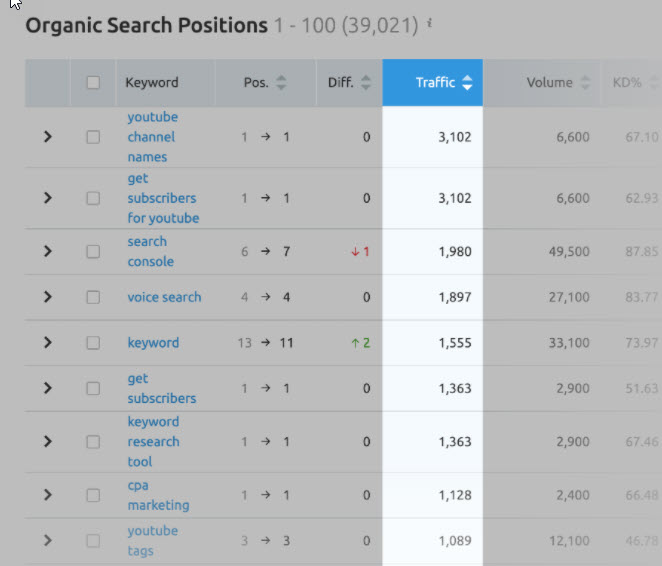
High-traffic keywords are considered the perfect start.
Besides, there are many other things you can do with this database.
For example, you also know which keywords are the most searched for.
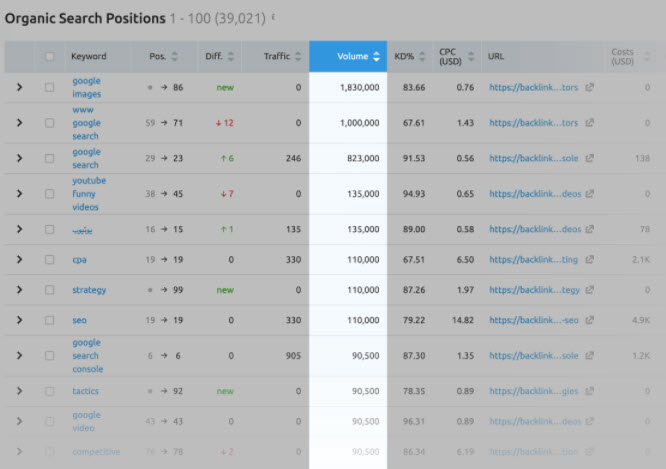
Also, you can use advanced filters. It will look for keywords with a CPC (cost-per-ad click) of $ 5 or more.
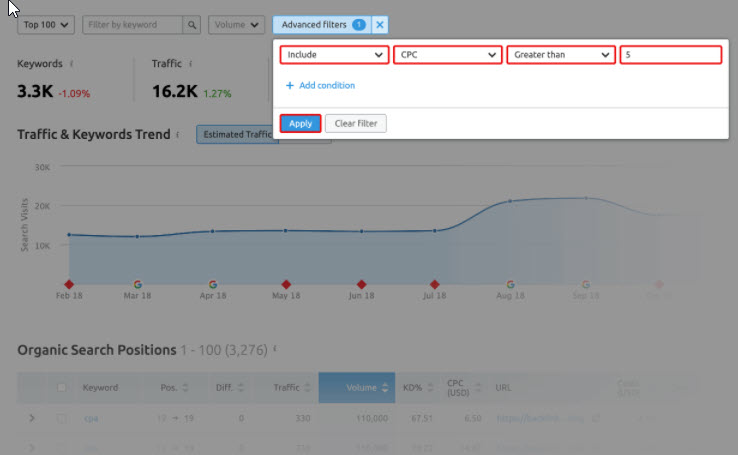
You can also filter out keywords with the SERP feature. This way, you will have a list of keywords that make as many clicks as possible without paying.

Summary:
The SEMrush organic search placement is where I usually start the keyword research process.
Unlike most other keyword research tools available today. This SEMrush feature gives me a list of terms for which I can easily rank them up.
2. Traffic Analytics - Traffic analysis.
Traffic Analytics on SEMrush is the analysis of data about the total number of visits on a website
It's not just traffic from Google.
In other words, the feature is SEMrush 's answer to SimilarWeb
And this is a very useful feature.
First of all, when you analyze a website with Traffic Analytics , you get an estimate of that page's total traffic:
This is very important as this will be the milestone you must reach in order to outdo your competition.
You can also see how users interact with that website. Specifically, you can see the average page visit, bounce rate, user stay time ...
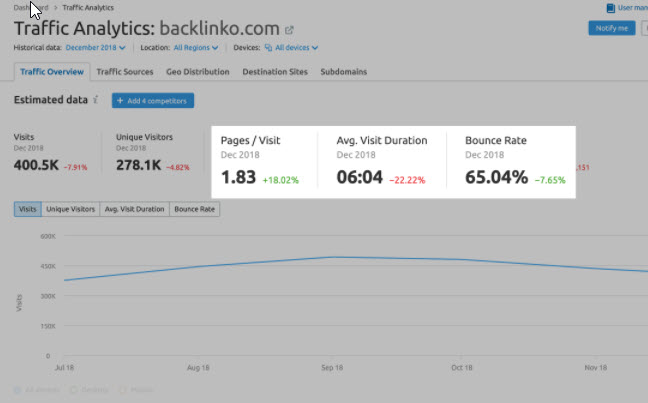
And you see a graph to see how these metrics have moved:

But the core of this feature is still Traffic Sources
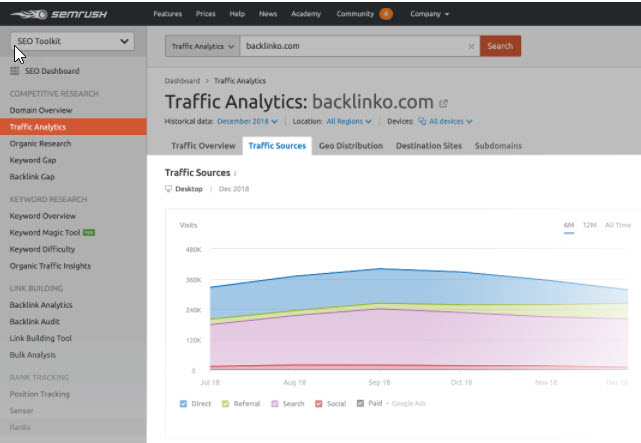
"Traffic Sources" is not simply a name!
Thanks to SEMrush 's "Traffic Sources" , you're not only seeing some unusual problem from a website's traffic source.
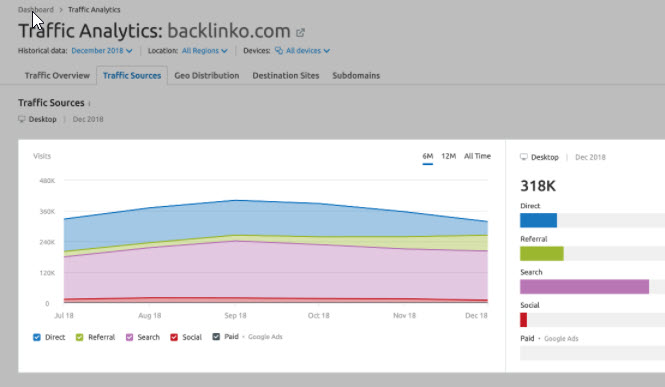
It's also an accurate list of the websites with the most traffic:
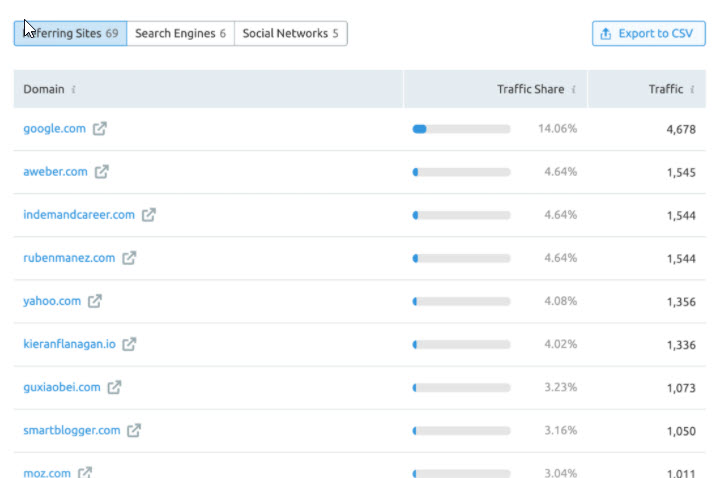
Example: You can see that I get a lot of traffic from WordStream.
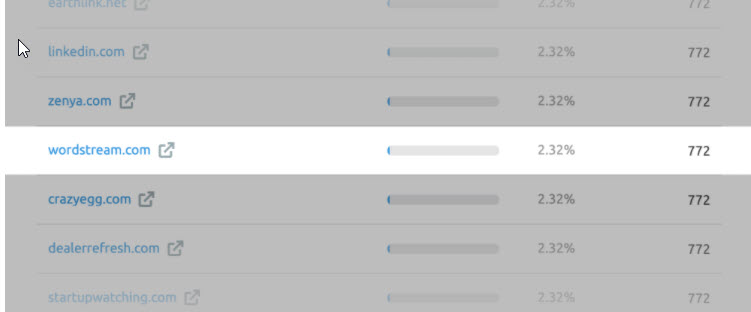
So, if you want to run a blog about digital marketing, you can post its features and features to your customers.
You can also see which social media or social networks have brought your competitors the most traffic.
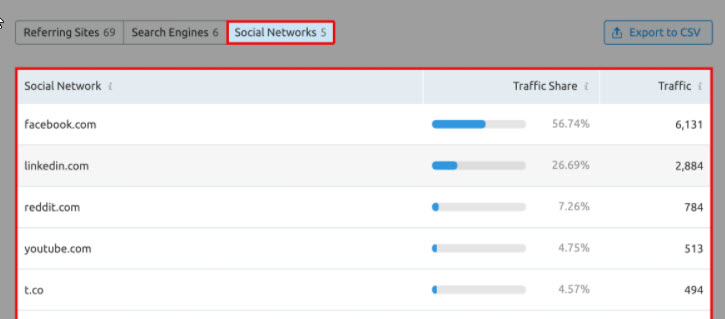
Again, here's how to see what your competitors have done for their website. If you use Google Analytics in combination, Google Tag Manager will understand user behavior on your own website. Then SEMrush is an important tool when analyzing the trial.
3. Paid Search - paid search engine
Currently most people apply SEMrush quite strictly for their SEO campaigns (SEO campaigns.).
But admittedly it is actually a useful PPC advertising tool.
Especially when you want to copy your competitor's keywords and advertising platforms.
Specifically, you can see which keywords your competitors are most often racing for:

In this case, you can see that Moz pays a lot for searches for brand data
However, they also accept to pay for searches for non-brand data.
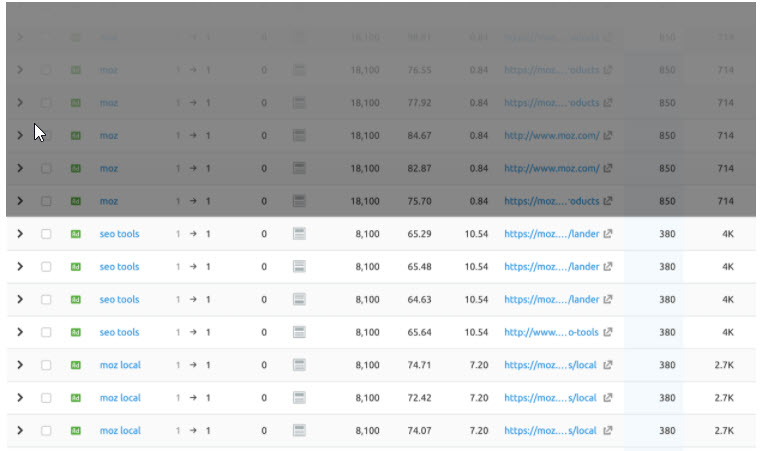
What's more, you can also see in detail the ads your competitors are running.

And you see an ad that has been running for months or years. You will understand for yourself that it has the perfect Quality Score.
That way, if you have a good grasp of your competitor's Google Ads advertising plan , you will have as good a result as them.
4. SEMrush - Keyword Gap
"Keyword Gap" shows you a list of keywords and its ranking on a multi-competitor website.
And when you find the same keyword on many competitors' rankings. You will know that it is a keyword that you can also get to the top of the search.
For example, when I put my two opponents in the tool. I found a bunch of really interesting keywords.

Tip: By default, this section shows you keywords that rank in the top 100 of Google search results. Obviously, if both competitors rank on page 5 for a keyword, then that makes little sense to you.
That's why I set up advanced filters. Here, I ONLY see the keywords that both websites rank for in the top 10:
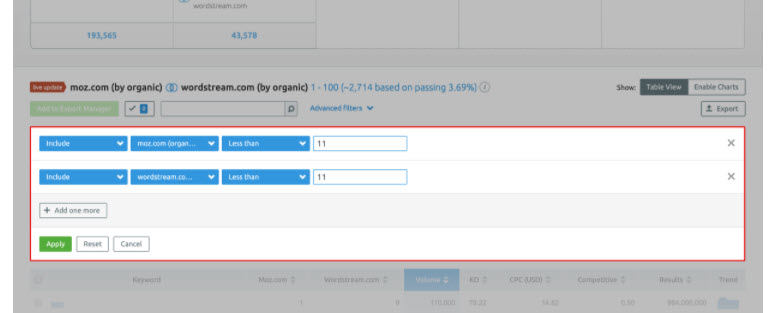
And that filter provided me with a list of the most useful keywords for SEO:
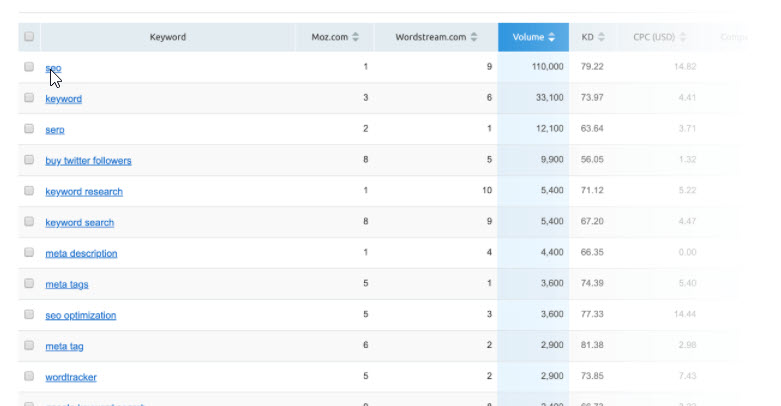
5. SEMrush - Keyword Overview
So far, I have mentioned how to know the technical principles, operating structure of competitors website.
This also confirms that: studying the operating principle of a website has made SEMrush 's brand.
And this also says, you can use SEMrush as your ideal and most frequent keyword search engine.
In other words:
You can include a keyword suggestion in the tool. You will then get a list of other keyword ideas related to the original keyword suggestion.
Example: Here, when I put "Paleo Diet" in SEMrush , I get the following result:
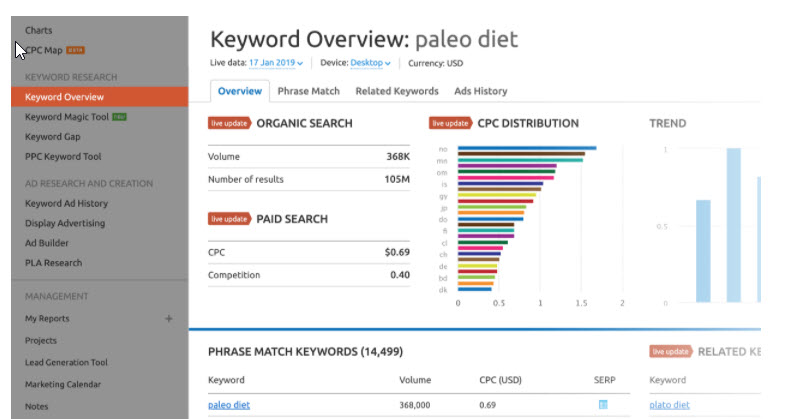
I will get some common data like: user keyword search volume and CPC.
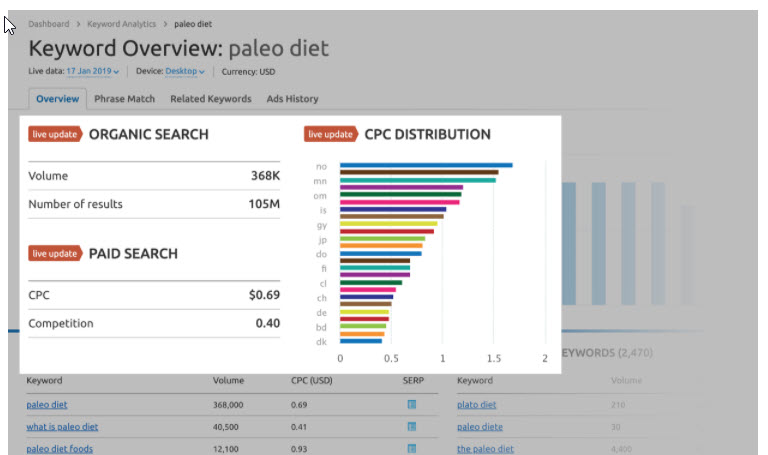
And I also get a transcript of keyword difficulty and competition.
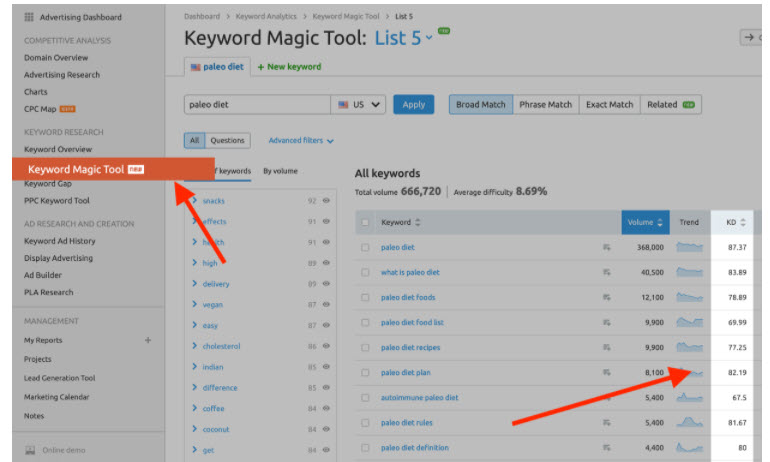
In addition, it also generates a list of suggested related keywords from the suggested keyword. (the related keyword phrase would have to contain the original keyword phrase)

Also, I will have new keywords that are related to my suggested keyword but not necessarily contain it.
And if you are interested in Google Ads, see which website is paying the most for that keyword:
6. SEMrush - Keyword Magic Tool
This function of SEMrush is understood quite simply
It generates a lot of keyword ideas.
For example, when I write Paleo Diet in KMT and search:
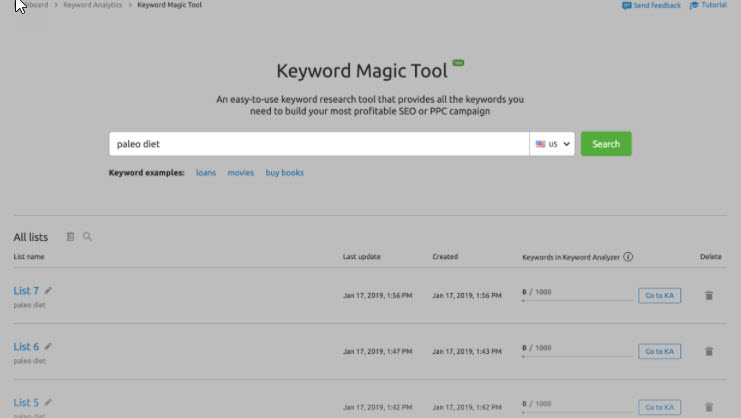
I get a fairly long list of 494,040 related keywords:
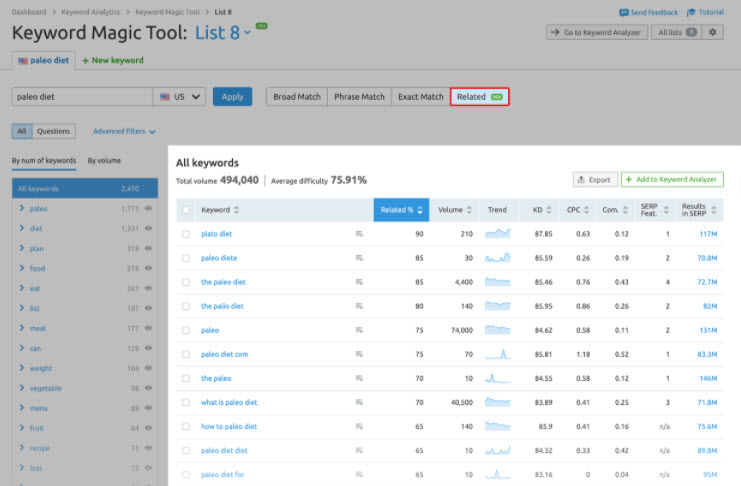
I can't believe it, it's 494k + keywords, guys!
You can sort the list by search volume, difficulty, CPC and more with the Keyword Magic Tool .
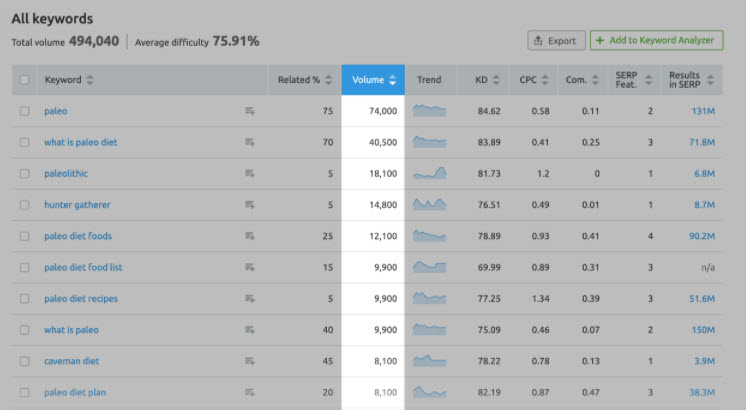
7. SEMrush - Keyword Difficulty Tool
Finding out how competitive a keyword is is also quite difficult!
You need to take into account all the following factors:
- Page authority
- Domain authority
- On-page SEO (optimize, improve website rankings)
- Content quality
- User intent
- And much more…
Enter: SEMrush's Keyword Difficulty Tool.
The Keyword Difficulty Tool doesn't analyze everything you need to know about a keyword. However, it helps you know if there is a chance to rank that keyword for your website.
To use this feature, enter the keywords you want to rank for here:
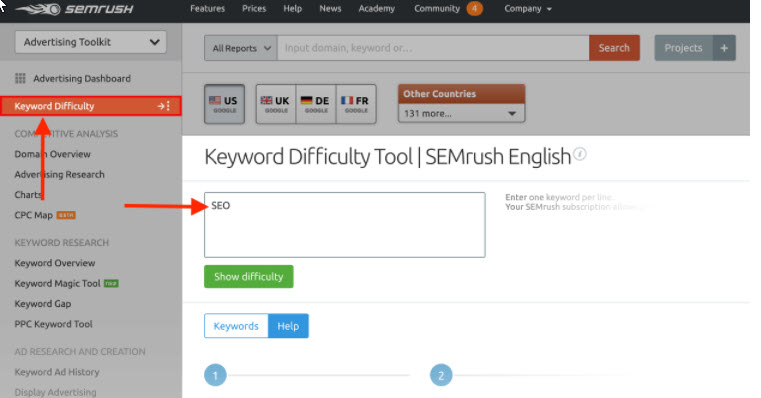
And you get a 0-100% rate for the competitive level of that keyword.
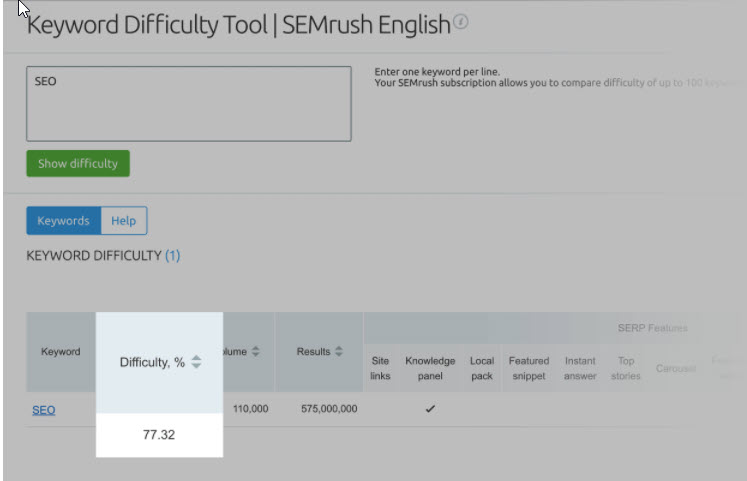
You can also compare the competition level of multiple keywords on this SEMrush feature . Thereby, you can find out which keywords you should target first:
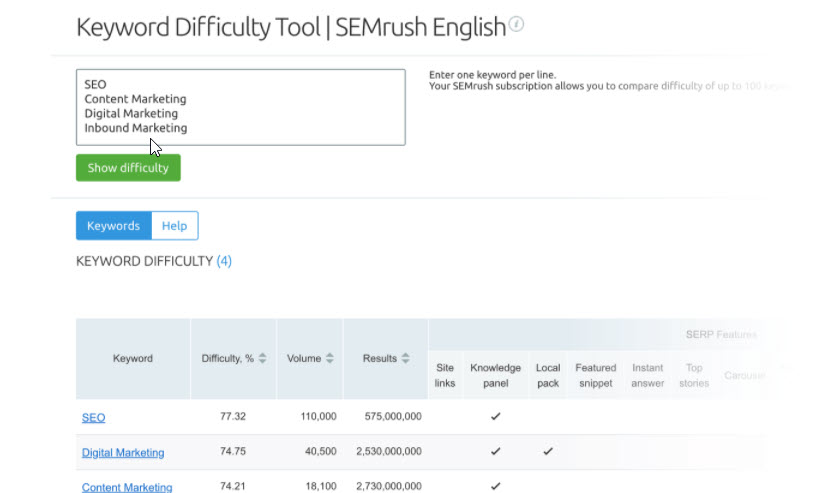
8. Position Tracking - track ranking
This is the rank tracking tool is SemRush built
It works like almost any other ranking checker on the market today.
You need to give it the domain name and keyword list ...
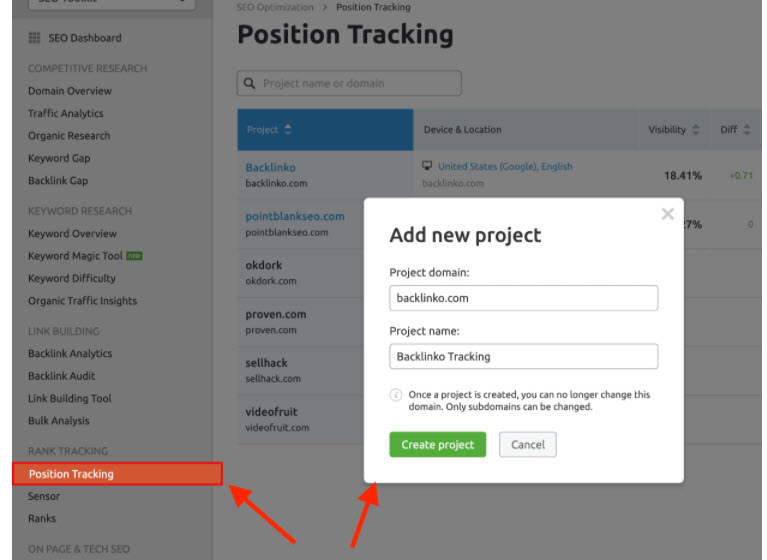
And you get daily updates on that keyword's ranking position.

In my experience this feature is quite reliable.
Because when checking your keyword rankings manually. They match exactly with SEMrush's result .
And this is my reason for using it.
What I love about it too is the default view of "Visibility Trend":

This result shows a change in your keyword rankings: it is in the top 100.
However, with this ranking results table, you can't tell which keywords are on page 2 and which ones are on page 10. So I think they should focus more on traffic. Thereby, it helps you see the keywords that have a chance to bring clicks to the searchers:

That's my only problem with “Position Tracking”. Overall, it's a pretty decent ranking tracking tool. It can completely compete with most other ranking trackers.
9. SEMrush - Site Audits
You can also use SEMrush to SEO site audits.
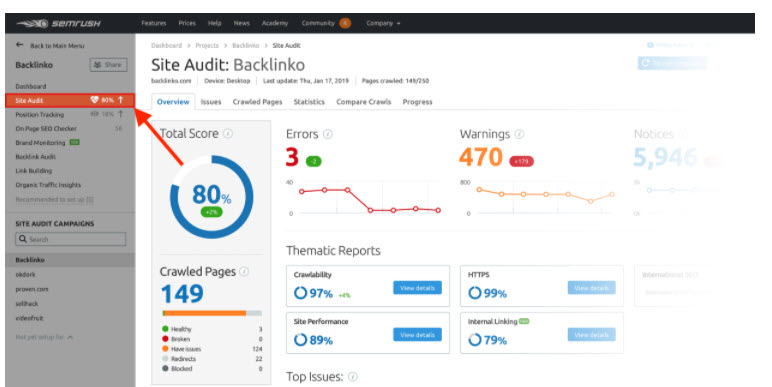
Specifically, you may see critical errors that can affect technical SEO:
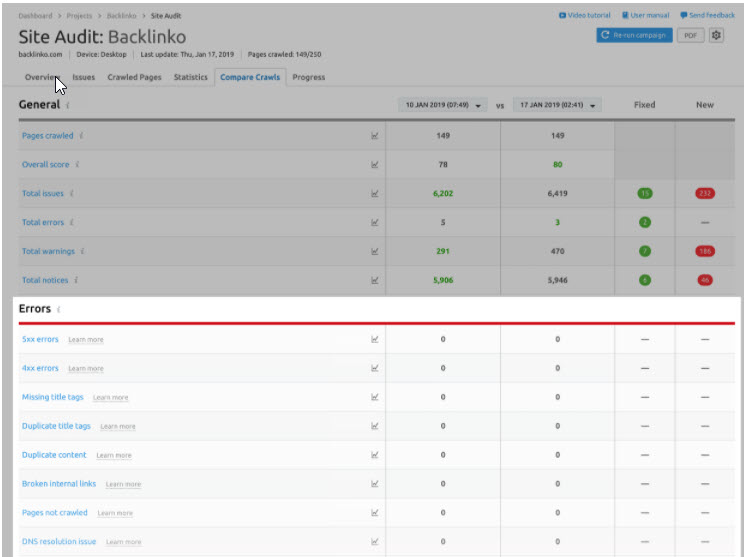
And warnings about some unusual problems that need to be fixed immediately.
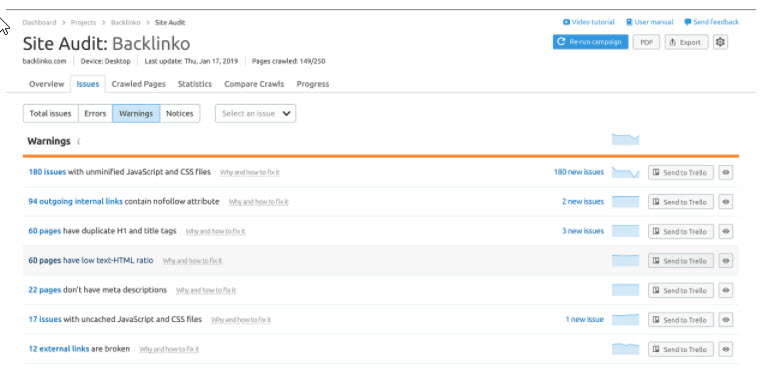
What's really cool about Site Audits is that you can compare information by day:

That way, you can see how your website optimization is going.
But what I like most about SEMrush 's SEO audits is that it is always in auto mode.
That is, you don't need to remember how often to site Audits once. You can see a Site Audits report that is always visible on your dashboard each time you log in.
10. SEO Content Template
This SEMrush feature is designed to help you write content that contains multiple LSI keywords. .
For example, let's say you want to rank for the keyword “Paleo Diet”.
Yes, SEMrush will analyze the top 10 results for that keyword.
And give you keyword synonyms. You can include your own post content .

There's even a tool to analyze the content of your draft:
There is even a "Quick Checker" tool on the SEO software SEMrush that will analyze the draft of your content. Accordingly, you see how well the keyword arrangement in there.

This result is very good.
11. Organic Traffic Insights
SEO professionals all have to know how to refresh their old data.
Yes, SEMrush has a "Organic Traffic Insights" feature so you can refresh keyword data from Google Analytics .
First, you need to connect your Google Analytics account and Google Search Console with SEMrush.

Then Organic Traffic Insights on SEMrush will analyze the data to find out which keywords have the most traffic for free:

Very useful, right?
12. SEMrush - Link Building
SEMrush 's link building feature is also quite good.
It's not as perfect though, like Ahrefs .
You can still do simple things like analyze the page links:

Analyze page links for usage for text usage, dofollow with nofollow, and overall link authority:

The special feature of SEMrush is that it has designed a tool to gather useful internal links .
Doing:
First, you put the keywords you want to search here:
Then, SEMrush will find pages that can link to the keywords you're trying to rank for:

You can even create a list of potential affiliate pages and reach out to that platform. BuzzStream, for example

13. On Page SEO Checker
This is the browser that analyzes your SEO content like title tag and H1 tag .

It also tells you about synonym terms that you should include in your content:

And the pages that you should get backlinks:

14. Social Media Toolkit
SEMrush gives you two tools to make analyzing social media easier.
With these 2 tools will allow you to create posts and monitor their performance. Also evaluate how well you are progressing against the competition.
Here are the features that Social Media Poster can do:
- Post to all of your social accounts from just one place
- Scheduled posting and queue management
- Save time with features that automate social media workloads
- Analyze your content's performance
- Create billboards thanks to chrome extensions
As for Social Media Tracker, will assist you with the following jobs :
- Utilize competitor analysis to create your own best strategies
- Will definitely help increase your performance
- Build the most perfect reports
To explore your competitor's social media strategy process, take the following steps :
Step 1: Set up the Project and launch the Social Media Tracker tool

Step 2: Set up complete information of your business. (1) Place the main company's profile. (2) Connect individual accounts from each channel to activate API. (3) Add competitor domain names and confirm their social media profiles that you want to analyze. (4) Select if you want to schedule an email report. (5) Start the tracker.

Step 3: Analyze your competitor's social media strategy on each channel. (1) Choose all the different profiles to analyze all your opponents at the same time. Determine how often they post and check the rate of interactions, shares, responses, and comments. (2) post theirs in this channel and set it as a benchmark for your performance. To see your own engagement rates in the comparison, just change all records and go back to your company profile.

Step 4: Determine which content formats of competitors are most successful: image, video, status, ...

Step 5: Identify competitor's top hashtags




